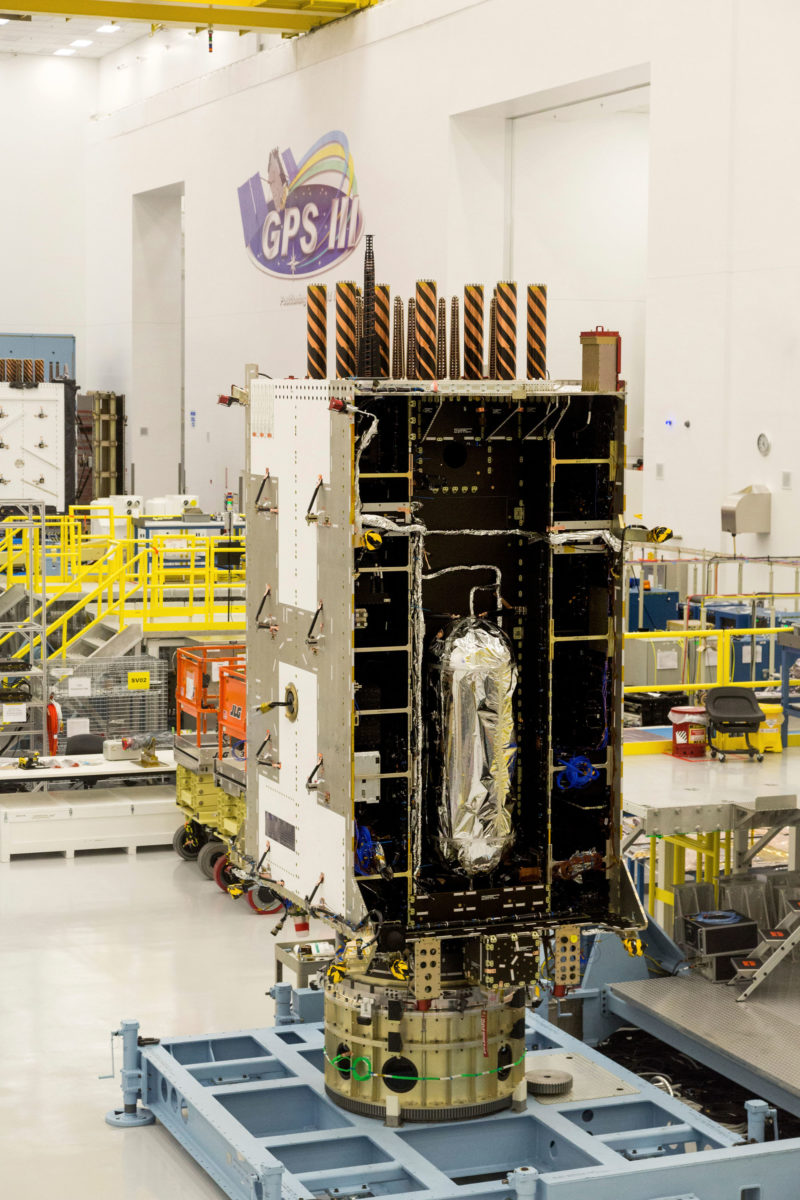
As SpaceX gears up for tomorrow’s 5:49 a.m. EDT Crew-2 launch from historic Pad 39A at the Kennedy Space Center (KSC) in Florida, the fifth Block III Global Positioning System (GPS) satellite has arrived on the Space Coast to begin final preparation for its own Falcon 9 climb to orbit later this summer.
The GPS III-05 spacecraft—built by Lockheed Martin at its customized GPS Block III facility, near Denver, Colo.—reached the Space Coast Regional Airport in Titusville on 6 April, aboard a C-17 Globemaster III cargo aircraft. Over the next few weeks, GPS III-05 will undergo post-shipment functional tests, propellant loading and encapsulation within the Falcon 9’s bullet-like payload fairing. Launch of the mission is scheduled to occur in mid-June.
The payload is the fifth GPS satellite (known as “Space Vehicle 05”, or “SV05”, in military parlance) in the Block III series and will be the fourth to ride atop the 230-foot-tall (70-meter) Falcon 9, coming hard on the heels of last November’s GPS III-04 launch and last June’s GPS III-03.

A SpaceX booster also lofted the first satellite in the series (GPS III-01) in December 2018, whilst another (GPS III-02) flew on the final United Launch Alliance (ULA) “single-stick” Delta IV Medium rocket in August 2019.
But whereas each of SpaceX’s three previous GPS launches used brand-new Falcon 9 cores, it was announced last September that the GPS III-05 bird would employ a previously-flown booster. That booster is expected to be the “B1062” core, which also provided the first-stage muscle to lift GPS III-04 on its way last November. As such, this upcoming mission will be the first National Security Space Launch (NSSL) to fly a used rocket.

GPS III-05 was delivered from Lockheed Martin’s facility in Waterton, Colo., to the Florida, by the U.S. Space Force’s Space and Missile Systems Center (SMC), headquartered at Los Angeles Air Force Base in El Segundo, Calif. The C-17 crew originated from Joint Base Lewis-McChord in Tacoma, Wash. Upon arrival on the Space Coast, the satellite was moved to the Astrotech Space Operations facility for checkout.
“SV05 is the third GPS III satellite shipped to the Cape in the last 14 months and marks a key step in our larger goal of GPS constellation modernization,” explained Col. Edward Byrne, SMC’s Space Production Corps Medium Earth Orbit Space Systems division chief.

“As the fourth GPS III launch campaign with SpaceX, this NSSL mission is historic both for the first reflight of a Falcon 9 rocket and for being the 24th Military-Code (M-Code) satellite introduced to our constellation, the last needed to bring M-Code to full operational capability.”
Building upon a GPS Navstar heritage dating back to the 1970s, Block III got underway two decades ago and the Air Force awarded Lockheed Martin a $1.4 billion contract in May 2008 to develop the first two Block III satellites in what will eventually comprise a 32-satellite network, with the first launch initially targeted for 2014. However, payload difficulties would ultimately push the program’s maiden flight back by almost five years and it did not launch until December 2018.

Following a Request for Proposals (RFP) issued by the Air Force in June 2017 for the fourth, fifth and sixth GPS Block III missions, SpaceX received the $290.5 million contract in March 2018.
Although SpaceX has successfully delivered two Block IIIs to orbit in December 2018 and June 2020, both flew under separate contracts. The first satellite flown under the $290.5 million contract was last November’s GPS III-04, with June’s GPS III-05 set to become the second. The sixth GPS Block III satellite is currently targeted for launch sometime next year.

Weighing 8,500 pounds (3,900 kg) and capable of a 15-year operational lifetime, these powerful satellites are built by Lockheed Martin at its customized GPS Block III facility near Denver, Colo. They are based upon the tried-and-true A2100 “bus”, whose modular framework produces 15 kilowatts of electricity via high-efficiency solar cells, radiation-cooled traveling-wave tube assemblies and improved heat-pipe design.
The expansive operational lifetime of each Block III bird represents a 25-percent quantum leap over earlier GPS satellite capabilities, as well as 500 times greater transmitting power, improved navigational warfare abilities, three times better accuracy and an eightfold enhancement in anti-jamming functionality.
All told, this enables GPS Block III to shut off service to limited geographical locations, whilst maintaining uninterrupted provision for U.S. and allied forces. It features a cross-linked command-and-control architecture, which permits the entire “constellation” to be updated from a singular ground station.
Furthermore, the satellites showcase a “spot-beam” capability for enhanced Military-Code (“M-Code”) coverage and better resistance to hostile jamming. These enhancements are expected to lead to improved accuracy and assured availability for military and civilian GPS users worldwide.

In keeping with tradition, the Block III birds are named for long-gone explorers, with the first and second honoring “Age of Sail” navigators Amerigo Vespucci and Ferdinand Magellan. More recently, the third satellite initially recognized Christopher Columbus, but was later renamed for the early 20th-century polar pioneer Matthew Henson.
And last November’s GPS III-04 paid tribute to Sacagawea, a Lemhi Shoshone woman of Idaho, who at the age of just 16 aided the Lewis and Clark Expedition to explore the Louisiana Territory in 1803-1806. She traveled with Lewis and Clark from North Dakota to the shores of the Pacific Ocean and played an important role in establishing cultural ties with Native American populations along the route. June’s GPS III-05 will be named for Neil Armstrong, the first man to set foot on the Moon.
FOLLOW AmericaSpace on Facebook and Twitter!
Missions » GPS » GPS 3 »





2 Comments
2 Pings & Trackbacks
Pingback:xyHt Weekly News Recap: 04/30/2021 - xyHt
Pingback:xyHt Weekly News Recap: 04/30/2021 - Open Source GIS - GIS Software & News